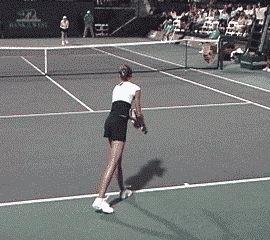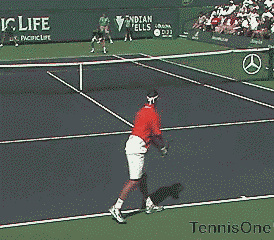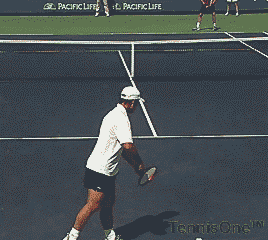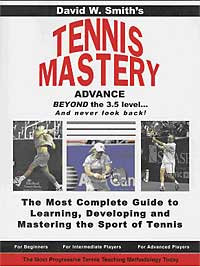|
TennisOne Lessons The Kick Serve Dave Smith TennisOne Senior Editor Using Juliet’s poetic phrase from William Shakespeare’s, Romeo and Juliet, ‘A rose by any other name would smell as sweet…,’ we could say that a kick serve by any other name would still bounce the opposite as a slice serve.
I use this literary allegory in describing the various names that the Kick Serve has been called historically and the confusion such terminology has created. In the 60’s and early 70’s the kick serve was often referred to as the ‘American Twist.’ More recently, the serve had been shortened to just ‘Twist.’ (The Serve: Spin Axis, Body Position, and Swing Path) Over the past ten years or so, the serve is now labeled simply ‘kick.’ I have heard people recently mention a ‘reverse twist’ or a ‘reverse slice’ serve, trying to describe the kick serve. These phrases usually used among those who don’t really know what a kick serve is or how one is correctly hit. Kick Serve Action as a Definition Technically, a kick serve is one that moves or behaves opposite to that of the normal slice action that most players first learn when they apply spin to a serve. That is, typically, right-handed players will swing forward, towards the net from left to right and brush some aspect of the right side of the ball (when looking at the ball from the back, viewing it towards the net while it is in the air over the server). Any such slice serve by a right-hander will curve to the left and bounce to the left. A kick serve is one that, when hit by a right-hander will curve to the right and bounce to the right. Because the swing mechanics of a kick serve tend to produce more of a topspin aspect to the ball than a true ‘left-hander’s slice,’ the term ‘kick’ has been used to describe this high-bouncing ball. The topspin nature of this ball bounces it higher than typical hybrid serves that have slice and some topspin. How to hit a kick serve (All descriptions are for right-handed players. For left-handers, reverse any of the directional directives.)
It is not uncommon to hear of players trying for years—if not decades!—and never successfully executing a kick serve intentionally. The reason for this is that the general swing pattern for most players on the serve often prohibits the necessary swing path for a kick serve. No matter how hard they try, they can’t hit a kick serve! (In fact, the harder they try, the more impossible it becomes! I will talk about this in a moment.) As I described in my article “The Serve: Spin Axis, Body Position, and Swing path,” for a kick serve to ‘kick’, the racquet path must move up the inside of the ball and brush up the left side of the ball, thus creating a spin axis that is almost horizontal as well as an axis that has its pole pointing towards the net. This ball will spin towards the right as well as have a significant downward arch. The main problems for most players lie in two elements of the serve that, once realized, opens the door for all players to gain a kick serve. Problem One: Elbow rotation Typically, as in any throwing motion, the initial moves include the arm rising, with the elbow pointing somewhat backwards. As the throwing hand begins to drop back (the collapse phase part in serving), the elbow moves forward creating a whip-like action of the hand and forearm which follow. The object of this movement is to maximize the hand speed when releasing the ball to be thrown. In tennis, this same motion is executed. However, once the elbow starts to lead the way, the racquet can only attack the ball from the back or the side of the ball. (Assuming the player is using a continental or even an eastern forehand grip.) When this movement occurs, it is nearly impossible to create a swing path that is up the inside of the ball. Problem Two: Shoulder Plane Rotation As in problem number one, as the throwing motion transpires, the upper body leads the way prior to the elbow’s rotation. This opening up of the shoulder plane (bringing the shoulders around to face the net), again prohibits the ability to create a swing path that produces a kick serve. While this motion is common in throwing and most serves, the kick serve requires a different path, one that is compromised when the body or the elbow rotates towards the net. Generally, when players try to swing harder or faster, the hitting shoulder rotates in even faster. Thus, as I mentioned earlier, the harder a player attempts to swing, the more impossible the kick serve usually becomes. Solutions First, try learning the kick serve on the ad side if you are right handed. This left to right trajectory is better suited to work on the proper swing path. Also, stand out wide, near the doubles alley. The more angle you can create, the more you can emphasis the kicking action and necessary swing path.
Stance: Stand with a fairly closed stance, where your bellybutton is facing almost facing the back fence. Grip: As with all good serves, the ideal grip is the continental. This grip will allow for the racquet face to be set properly for the necessary swing path. Window Pane: Imagine there is huge window that extends up out of the baseline as high as you can reach. When you serve, picture that you can only swing parallel to the window when hitting the ball—instead of swinging through the window and breaking the glass. (For right-handers, this would be an exaggeration of the left to right swing path.) When you swing, imagine that you DON’T want to break the glass. This analogy will help in both the two problems I mentioned earlier. In order to not break the glass wall, you will have to stay sideways with your body and you will also keep your elbow back longer. Sideways Position: As I just mentioned, you will want to consciously try to stay sideways to execute the kick. Almost every player I have ever seen attempt the kick, tends to rotate too early. You will need to override this tendency until you get a feeling for the serve. Elbow Position: Leave the elbow back much longer than your normal serve. That is, try not to start the serve with the elbow leading the way. Get your racquet to start up first. Brushing Action: Toss just slightly over your head. (If you follow these instructions, you don’t have to toss way behind you, nor, arch your back a great deal. Although, when you master the kick, slight variations can add emphasis to the kicking action.) When looking up, focus on the inside portion of the ball. (The side of the ball nearest to you.) This is the side that you are going to want to attack, brushing up and out away from you. At contact, your racquet should still be moving up and to your right, towards the sky. After contact, the racquet then continues around your body as in a normal finish. American Twist Difference The ‘American Twist’ did have one difference in execution from that of the modern kick serve. The American Twist was usually taught to have the racquet finish on the same side as the hitting arm. This awkward finish put a lot of strain on the arm as well as the back as this motion also used a greater arch in the back to gain access to the inside portion of the ball. Today, we have found that if the player stays sideways and holds back their hitting elbow, the swing path can brush the inside of the ball, allow pronation, and then relax across the front of the body as normal serves.
The Reverse Twist There is a serve called the 'Reverse Twist' - a serve that is more of a trick serve than something most pros would intentionally teach. The reverse twist could probably be better named the 'reverse slice' since it is, in reality, a slice serve hit in reverse (See Dave's video demonstrating this serve at the top of the article). It is a fun serve to try and I have actually played against several players who had mastered the serve and turned it into quite a weapon, since the spin is truly that of a left-handed server for a right-handed players. The Reverse Twist is hit facing the net and holding nearly a full western forehand grip. The toss is forward in front of the player towards the net, and the racquet action is significantly from right to left for a right-handed server. The idea is to brush the left side of the ball, nearly along the equator of the ball as if were on a true north/south axis (Like that of the earth spinning). A player can swing quite substantially from right to left with this body and toss position. It does take a few serves to get the feel of brushing this left side of the ball in the opposite direction. However, with a few body position adjustments, a player can learn to get this serve in quite easily. I don't recommend this serve, however, until the player has mastered the more conventional serve. Yet, when we intentionally try new things, we can discover other things about our strokes and what we can do to a ball in the process. Conclusion While these directives are key points in hitting a kick serve, most players will have subtle idiosyncrasies that vary the overall delivery. Also, once the general swing path is understood and the player can execute the serve intentionally, the player may indeed evolve the kick serve to become more effective as well as more comfortable and consistent. However, the general swing path necessary for a kick serve will feel very uncomfortable and foreign to most players first trying it. It is advisable to work the kick serve for several days, if not weeks, in small steps. This will avoid injuries or fatigue, (which often can cause injuries when players are unfamiliar with a desired stroke or technique). Your comments are welcome. Let us know what you think about Dave Smith's article by emailing us here at TennisOne .
TENNIS MASTERYFinally. a resource that unlocks these mysteries: • Why do m • Why are making changes in one's game so frustratingly difficult? • What tennis teaching methods are disruptive or detrimental to player progression? Read David W. Smith's TENNIS MASTERY and learn not just how to avoid playing at mediocre levels, but how the best players in the world Master the sport of tennis! "With a depth of knowledge and fresh perspective, TENNIS MASTERY is set to become a manual for tennis instructors and a measure for tennis literature." Richard Wigley, Director, Kayenta Tennis Center, Ivins Utah. Take in David Smith's 30 plus years in the tennis teaching industry. This 335-page manual will provide for every level of player as well as support for all tennis-teaching professionals, a blueprint for reaching higher levels of tennis mastery. Order TENNIS MASTERY at tenniswarehouse.com , or go to tennismastery.net for exciting excerpts from the book and a host of tennis information! And check out David Smith's other articles found here at TennisONE.com Learn more from Dave Smith at his Desert Shadows Tennis Institute!
Call (435) 628-5000 and ask for the tennis pro shop to learn more about Desert Shadows Tennis Institute. Learn the Advanced Foundation, discover tools to master more advanced techniques for all strokes, and discover that staying at the same level you are is NOT AN OPTION! A select number of camps are available but space is very limited. The DSTI camps take place in St. George, Utah, in the heart of ‘Color Country’—the incredible beauty of Southern Utah. Zion, Bryce Canyon and Grand Canyon National Parks are all nearby! Hurry to reserve your spot now for a true ‘tennis destination’ opportunity! “The most informative, intuitive tennis camp I have ever attended.” Randy S. Colorado “Dave and his staff have a passion for the game and a personal care for their students.” S. Loo, Nevada “The depth of instruction is far superior to that of other tennis camps I’ve been.” Tom T. Nevada |




 illions of tennis players stagnate at levels far below their potential?
illions of tennis players stagnate at levels far below their potential?  Join Dave Smith in an intimate, ultimate tennis camp: Desert Shadows Tennis Institute (DSTI) is an intense, 3-day camp that accepts only 12 players to work directly with Dave and his staff of certified and accomplished pros. Over 18 hours of tennis instruction is included along with a copy of Dave’s best-selling tennis book, TENNIS MASTERY, a DVD of instruction, breakfast and lunch each day, and a lifetime of tennis secrets!
Join Dave Smith in an intimate, ultimate tennis camp: Desert Shadows Tennis Institute (DSTI) is an intense, 3-day camp that accepts only 12 players to work directly with Dave and his staff of certified and accomplished pros. Over 18 hours of tennis instruction is included along with a copy of Dave’s best-selling tennis book, TENNIS MASTERY, a DVD of instruction, breakfast and lunch each day, and a lifetime of tennis secrets!